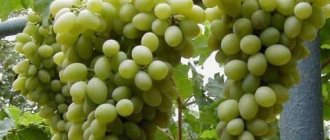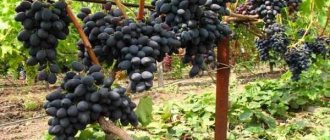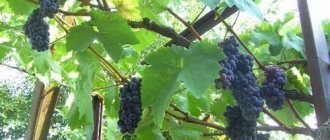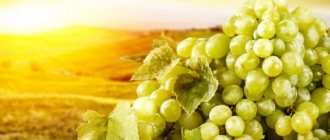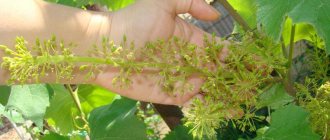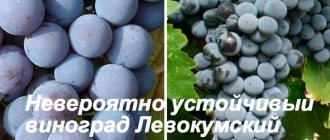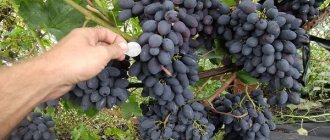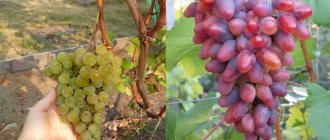What kind of variety is this
The grapes were bred by specialists from the Research Institute named after. Potapenko. This is a wine variety characterized by high sugar content. Due to their taste, the fruits are used to make wine of elite alcoholic brands.
One of the main advantages of the variety is its resistance to low temperatures. Without creating a special shelter, the grapes can withstand the harsh winter conditions in central Russia. There is also a strong immunity, thanks to which it is possible to avoid infection with common diseases.
Maxi black grapes: wine grapes for the northern regions
Purposeful work on breeding a variety suitable for the conditions of the middle zone gave the result in the form of Maxi black - a grape characterized by high fertility and frost resistance .
Description of the variety
Juicy, crispy pulp with a high sugar content.
The breeding of the variety was carried out by specialists from the Research Institute named after. Potapenko Ya.I.
Maxi black is a wine grape with a high sugar content and is ideal for the production of an elite alcoholic drink.
One of the main advantages of this variety is its high tolerance to low temperatures without the use of special shelters . But breeders are also distinguished by their unpretentiousness in cultivation and care and good resistance to most diseases.
Maxi white
Interestingly, along with the Maxi black variety, the Maxi white variety was bred, which has similar characteristics, but is classified as a table grape variety.
Bushes
An adult bush of Maxi Black grape variety.
- Bushes of this species are characterized by an average growth force ( 2 meters per year ).
- Their full maturation period is 4–5 years .
- The leaf plate is slightly curved, its shape resembles a funnel, and is elongated in the longitudinal direction.
- Young leaves are characterized by the presence of small bronze-red spots.
- When reaching full strength, the color changes to solid green.
- The surface of the plate is smooth, without the pubescence inherent in many types.
- The dissection between the blades is poorly visible.
- The leaves are quite large and have a jagged edge.
Characteristics and description
Plant growth is moderately intense. The vine reaches a height of up to 2 meters. It takes about 5 years for the culture to fully mature. The curved shape of the leaf resembles a funnel in appearance. Young greens have bronze-red spots. As the bush matures, the leaf color evens out to a rich green. There is no edge on the smooth surface of the plate, which distinguishes the variety from many varieties of grapes.
The bunch is dense with small branches, medium in size. It is similar in shape to a cone. Average weight - 300-350 g. The diameter of the berries does not exceed 3 cm, weight - 3-4 g. The shape of the fruit is oval. The skin color is dark purple, the juice is clear. The pulp is juicy with a high sugar content (within 21-22%).
Reference! The fruits of the Maxi black grape are an ideal material for winemaking. High taste characteristics make it possible to get enough of the refreshing notes when eating berries fresh.
Grapes Maxi
Maxi is an elite early ripening grape variety, distinguished by large fruits, sweet taste and resistance to low temperatures. There are white and black varieties of such grapes.
Description of the variety maxi white
The characteristic botanical features of this grape are as follows:
- The leaves of the plants are large, bright green in color, five-lobed, glabrous, and have a slight dissection. Along the edge of the leaf there are mild, medium-sized teeth.
- The brushes are elongated and dense. The weight of one bunch can reach 1 kg. The berries are juicy, sweet with a pleasant sourness and fruity aroma, covered with a dense, crispy skin of a soft green or yellow-green hue. They have an oval shape. The berries are large and can reach 5 centimeters in diameter.
This variety belongs to the category of early ripening grapes.
The vine ripens and begins to bear fruit at the end of August, but mid-September is considered the best time to harvest. The yield is high, the weight of berries collected from one bush can reach 50 kg. The bushes are of medium vigor; maturation of the bush to full vigor is from 4 to 5 years. The optimal distance between seedlings is 1-2 m. It has good frost resistance - it can tolerate temperatures from -24 to -27 degrees. Resistance to fungal diseases and pests is average. This variety is mainly grown for fresh sale. Despite its high taste, it is rarely used for making wine. Thanks to its dense skin, the grapes tolerate transportation well. The berries retain their beneficial qualities and presentation for a long time when stored.
Description of the variety maxi black
Its botanical characteristics include:
- Large, five-lobed, bare, funnel-shaped leaves, elongated along the midrib, have a green color with copper-colored spots. The upper cuttings of the leaves are small and of medium depth, the lower ones are weakly outlined. Along the edges they are covered with denticles of different heights with a wide base and smooth edges. The leaves of the plants have a slight dissection. The petiole is slightly shorter than or equal to the midrib of the leaf.
- The grape clusters are large, dense, conical in shape with a large blade. The weight of the bunch is about 300 g. The berries are large, oval, black or violet-blue, juicy. Sugar content is up to 18%. The berries are covered with a thick skin with a waxy coating. They have a sweet taste and pleasant smell, their juice is not colored.
The black variety is also classified as an early ripening grape.
Berries begin to ripen in mid-August, and harvesting generally occurs in mid-September. The bushes are vigorous, throwing out up to 15-18 shoots. A full harvest can be obtained 3 years after planting. The recommended pruning of bushes is an average of about 1 meter. The yield of bushes is high - on average 140-150 centners per 1 hectare. The plants are winter-hardy; the vine can overwinter under snow cover without shelter and tolerate temperatures as low as -25 degrees. In case of stronger cold weather, it is necessary to cover the shoots for the winter. Plants are not very resistant to diseases and pests and can be affected by mildew and phylloxera. In this regard, they require strict care and special treatments. The berries are versatile; they are used both for fresh consumption and for making table red wines. The sugar content in the juice of such grapes is 21-22 g/100 cm3, the acidity is 7-8 g/dm3, and the acidity reaches 7-8 g/dm3. The tasting score of wine made from this variety is 7.6 points.
The grapes tolerate transportation well and long-term storage is possible. Fresh berries contain a lot of useful substances and have antispasmodic and antioxidant properties. They help well against edema. 80 grams of these berries contain 15% of the daily requirement of vitamin C. Regular consumption of this product is especially useful for people suffering from cardiovascular diseases.
Despite the obvious differences, these varieties have a lot in common. First of all, it is the size of the berries, which is how they get their name. They are united by winter hardiness, which allows these plants to be grown not only in the southern part, but also in central Russia. In addition, they are united by such qualities as early ripening, abundant yield, good transportability, high taste characteristics of the fruit, and excellent presentation. It is thanks to these qualities that they are considered elite, and they are in demand and loved by gardeners.
Advantages and disadvantages
Maxi black is popular among farmers of large farms and private owners due to the following advantages:
- low-labor agricultural technology;
- high and stable yield (up to 14 tons are harvested per hectare);
- high frost resistance (up to minus 27 degrees);
- good transportability;
- long shelf life of the crop;
- resistance of the crop to many common diseases and pests;
- high sugar content;
- excellent taste characteristics;
- universal application.
The variety has no significant disadvantages. Only a couple of nuances stand out:
- phylloxera creates problems when growing;
- long period of ripening of berries (about 155 days).
What care measures should be taken?
Recently created, the Maxi variety is not often cultivated. It is not yet possible to put together a complete picture. Winegrowers do not always leave descriptions of the difficulties of care and the intricacies of cultivation. Information characterizing the negative aspects is missing, or comes from inexperienced farmers.
Competent people note:
- To prevent plant damage by pests, protective equipment is used. From oidium to flowering, the vine is treated with Fundazol, Benleit, colloidal sulfur, and other sulfur substances. Bordeaux mixture (1% solution) and fungicide spraying with polychome and cuprosan are used against mildew. Gray rot on green bushes and shoots is destroyed by Bentleit, Topsin, Euparen.
- Seedlings may suffer from diseases due to unfavorable weather, lack and excess of nutrients in the soil.
- The cuttings take root well. With quality care, the grapes bear fruit well and show high yields.
Maxi is in demand among consumers due to its excellent taste and winemaking qualities.
Maxi grape cuttings take root well
Landing rules
Taking into account the climatic characteristics of the region, the time for planting cuttings is determined. This can be done both in autumn and spring.
Experts advise planning planting for the spring. This will make it possible for the plant’s root system to become stronger during the warm season and to stock up on energy. In winter, a vine that has gained strength will be able to withstand frosts more easily.
Reference! In regions with cool climates, planting is carried out no earlier than May. In the south, work is planned for late March - early April. The favorable period for autumn planting is from September 15 to October 15.
The place for grapes is chosen from a windproof side, where there is enough sunlight. These criteria correspond to areas on the south side of the garden or local area.
Maxi black grapes are characterized by medium vigor. The cuttings are planted at intervals of 3 to 4 meters. Planting holes need to be prepared in 1-1.5 months. Their parameters are standard: 90 cm in depth, width and length.
The bottom part is covered with drainage. For these purposes, it is appropriate to use fine crushed stone, gravel or expanded clay mixed with coarse sand. Afterwards, a nutrient mixture of fertile soil, fertilizers and peat is introduced. After watering, the hole is left to settle for at least a month.
The young vines are planted at the scheduled time. It is carefully placed in the center of the hole, and a support (metal rod or wooden beam) is dug in nearby. Then dig in with soil with light compaction. The work is completed with generous irrigation.
Diseases and pests
One of the main advantages of the variety is resistance to common diseases and pests. However, this quality does not replace preventive measures. During the season, 2-3 treatments with fungicides should be carried out. Such measures prevent infection with mildew and oidium.
A real scourge for winegrowers is aphids or the so-called phylloxera. When pests invade, it is almost impossible to cure the plant. The problem can be solved through timely prevention. For these purposes, it is recommended to use the following compositions:
- Fastak;
- Confidor;
- Bi 58.
Among effective folk recipes, experts recommend spraying with soap or tobacco solution, dusting with wood ash or crushed citrus peel.
Collection, storage and use of crops
The growing season of the Maxi black variety is 153-156 days. The first bunches are ready for harvesting around the end of August. The grapes ripen at the same time, which facilitates and shortens the harvesting process. To separate the bunch from the branch, use a tool with a sharp blade.
There are some requirements for crop storage conditions:
- choose a sunny day for picking berries (after lunch, when the dew dries);
- when contacting bunches, care must be taken not to damage the waxy coating on the berries;
- The bunches are placed in boxes after sorting by size, the stem is placed upward;
- cut grapes are shaded with paper or cloth to protect from sunlight;
- upon completion of assembly, the boxes are sent to storage, where a stable temperature is set in the range from 0 to +2 degrees (humidity should be about 80-90%);
- One of the storage requirements is the absence of sunlight.
Watering and fertilizing
Regular watering of crops affects the productivity and quality of the crop. The soil is moistened every month.
- The first time - during the dissolution of the first leaves,
- the second - just before flowering,
- the third - during the ripening period of the berries.
During the ripening period of berries, watering is required.
Under no circumstances should grapes be watered during the flowering period or less than 2 weeks before the harvest ripens . This can lead to the flowers falling off and the berries of the variety cracking.
Reviews about the variety
- Mikhail Sergeevich, Yaroslavl
I learned about the Maxi black variety by chance from a relative who brought several vines as a gift for planting. They presented me with grapes as frost-resistant, easy to care for, and sweet in taste. All the cuttings took root.
The first year I covered the young shoots with agrofibre and pine branches. In the third year the first bunches appeared. There were from 6 to 17 of them on each vine. 5 years have passed, the plant has gained full strength. Now I remove 15-17 kg from a bush.
- Oleg, Ishim
I'm interested in winemaking. Friends advised me to plant the Maxi black grape variety. My relatives enjoyed tasting the first berries that appeared in the third year after planting the cuttings. Already in the fourth year we managed to stock up on material for wine.
Plant care is minimal; the plant tolerates even our harsh winters well. The quality of the resulting drink fully corresponds to the varietal characteristics. Yields are average: about 10-12 kg per bush.
- Tamara, Leningrad region
Sunny weather in our region does not happen as often as we would like. Therefore, when choosing grape varieties, I had to sift through a lot of information and listen to the opinions of experienced gardeners. Many people recommended trying the Maxi black variety. The culture’s ideal combination of frost resistance and strong immunity was captivating.
The growing season is long; harvesting can begin 155 days after the buds have revived. But the berries ripen together, which speeds up the harvesting period. Fresh berries are well preserved in the cellar until the end of November. But I process most of it into wine.
Video review of the variety and its comparison with Tonus grapes:
Features of agricultural technology of the variety
“Maxi Black” refers to varieties with a non-capricious character. Even a novice winegrower can plant a crop and care for it. Like any variety, this grape requires special care.
Landing
Planting dates depend on the region of cultivation and planting material:
- April 15 - May 15 – annual lignified seedlings;
- May 25-June 30 – vegetative, green.
Autumn planting takes place in September or October, depending on the climate. The main thing is to follow the rule - planting work must be completed a month before the onset of frost.
Grapes are not picky about the composition of the soil. The exception is salt marshes and areas with high groundwater. In such areas the tree will become sick and eventually die. Ideal for plants would be soil with the following characteristics:
- neutral in acidity;
- sandy loam or loamy in composition;
- loose and moisture-absorbing in structure;
- fertile.
The algorithm for direct planting of seedlings is similar to the procedure for planting any variety and has some features depending on the time of work.
Rules of care
“Maxi Black” does not require special attention. The culture, resistant to low temperatures, frees gardeners from the need to build a winter shelter. The variety, which is immune to diseases and pests, allows you to grow an environmentally friendly crop without the use of chemicals. Simple care consists of forming a bush, watering and fertilizing as necessary.
Watering
The first year of grape life in the irrigation area is carried out according to a special scheme:
- first month – once a week;
- third month – once every two weeks;
- further - as the soil dries within the planting pit.
Such watering will ensure better survival of young trees.
Starting from the second year of planting, experienced winegrowers recommend watering grapes during periods when the plant requires the greatest amount of moisture:
- when buds open;
- at the end of the flowering period;
- during berry ripening.
It is always necessary to regulate the frequency of irrigation of the vineyard, taking into account specific weather conditions.
You should know!
The grapes should not be watered during flowering. In addition, watering must be stopped two to three weeks before this period. Excessive moisture impedes the supply of oxygen to the roots, the plant loses strength and sheds its ovaries. You can deviate from this rule only in case of prolonged drought.
Bush formation. Trimming
For this variety, it is recommended to form it into a two-armed or one-armed cordon. Since plants are not afraid of frost, the cordon does not have to be horizontal. The task of the first year is to grow one or two powerful shoots, future “shoulders”. To do this, you need to remove the stepsons during the summer, and at the end of the summer season, remove the growing point.
In the second year, sleeves need to be grown on the existing “reliable shoulders”; there should be no more than eight of them. It is advisable to maintain a distance between the sleeves of at least 40 cm. The optimal number of fruit shoots is 16-18 pieces per bush, no more. The length of pruning fruit clusters is short - 3-4 eyes.
